Make 50000.00 a Year With 6 Months of Schooling
Average Cost of College & Tuition
Last Updated: November 15, 2021 by Melanie Hanson
Report Highlights. The average cost of college* in the United States is $35,720 per student per year. The cost has tripled in 20 years, with an annual growth rate of 6.8%.
- The average in-state student attending a public 4-year institution spends $25,615 for one academic year.
- The average cost of in-state tuition alone is $9,580; out-of-state tuition averages $27,437.
- The average traditional private university student spends a total of $53,949 per academic year, $37,200 of it on tuition and fees.
- Considering student loan interest and loss of income, the ultimate cost of a bachelor's degree may exceed $400,000.
*In this report, college refers to any postsecondary educational institution that offers an undergraduate degree program.
Jump to a state: AL | AK | AZ | AR | CA | CO | CT | DE | FL | GA | HI | ID | IL | IN | IA | KS | KY | LA | ME | MD | MA | MI | MN | MS | MO | MT | NE | NV | NH | NJ | NM | NY | NC | ND | OH | OK | OR | PA | RI | SC | SD | TN | TX | UT | VT | VA | WA | WV | WI | WY
| Public Institutions | Cost of Tuition | Additional Expenses* | Cost of Attendance |
|---|---|---|---|
| 4-Year In-State | $9,580 | $16,284 | $25,864 |
| 4-Year Out-of-State | $27,437 | $16,284 | $43,721 |
| 2-Year In-State | $3,372 | $12,665 | $16,037 |
| Private Institutions | Cost of Tuition | Additional Expenses | Cost of Attendance |
| 4-Year Nonprofit | $37,200 | $16,749 | $53,949 |
| 4-Year For-profit | $13,475 | $21,073 | $34,548 |
| 2-Year Nonprofit | $17,294 | $17,262 | $34,556 |
| 2-Year For-profit | $15,974 | $13,984 | $29,958 |
*Additional expenses do not account for potential lost income nor student loan interest.
Related reports include Student Loan Debt Statistics | Average Cost of Community College | How Do People Pay for College? | Student Loan Refinancing
Average Total Cost of College
The total cost of college includes more than the cost of attendance (COA), which refers to the total cost of tuition and fees, books and supplies, as well as room and board for those students living on campus.
- The average cost of attendance for a student living on campus at a public 4-year in-state institution is $25,864 per year or $103,456 over 4 years.
- Out-of-state students pay $43,721 per year or $174,885 over 4 years; traditional private univeristy students pay $53,949 per year or $215,796 over 4 years.
- While 4 years is the traditional period to earn a bachelor's degree, just 39% of students graduate within 4 years.
- 60% of bachelor's degree earners graduate within 6 years, totaling an average of $155,184 for the cost of attendance.
- Students unable to work full-time stand to lose $39,676 in yearly income.
- Student borrowers pay an average of $1,898 in interest each year, and the average student borrower spends 20 years paying off their loans.
- Considering lost income and loan interest, the ultimate price of the average bachelor's degree may be as high as $400,793.
| Public Institutions | Total Cost of Tuition | Total Additional Expenses | Total Cost of Degree |
|---|---|---|---|
| 4-Year In-State | $38,320 | $65,136 | $103,456 |
| 4-Year Out-of-State | $109,748 | $65,136 | $174,884 |
| 2-Year In-State | $6,744 | $25,330 | $32,074 |
| Private Institutions | Total Cost of Tuition | Total Additional Expenses | Total Cost of Degree |
| 4-Year Nonprofit | $148,800 | $66,996 | $215,796 |
| 4-Year For-profit | $53,900 | $84,292 | $138,192 |
| 2-Year Nonprofit | $34,588 | $34,524 | $69,112 |
| 2-Year For-profit | $31,948 | $27,968 | $59,916 |
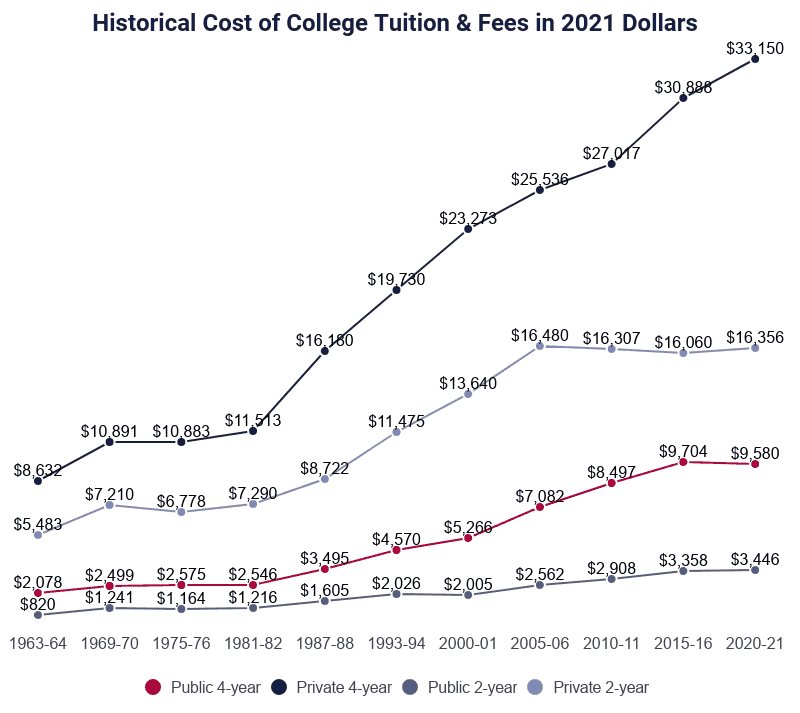
Average Cost of Tuition
Tuition and fees make up the bulk of most college students' educational expenses.
- The average cost of attendance at any 4-year institution is $25,362.
- The average cost of tuition at any 4-year institution is $20,471.
- At public 4-year institutions, the average in-state tuition and required fees total $9,308 per year; out-of-state tuition and fees average $26,427.
- At private 4-year institutions, the average tuition and fees at a nonprofit college total $35,801 annually; at for-profit institutions, tuition and fees average $15,156 annually.
- The average cost of tuition and fees at any 2-year institution is $6,379.
- At public 2-year institutions, or community colleges, in-district tuition and fees average $3,412 annually; the average for in-state students is $4,444, while out-of-state students pay an average of $8,516.
- At private 2-year institutions, students pay $17,128 in annual tuition and fees to attend nonprofit schools; for-profit colleges charge $15,821.
- Among the comparatively few institutions that offer programs of less than 2 years, the average annual tuition and fees are $12,735.
- Most institutions designated less-than-2-year are private, for-profit schools.
- There are not enough data available regarding these institutions to derive much statistical meaning.
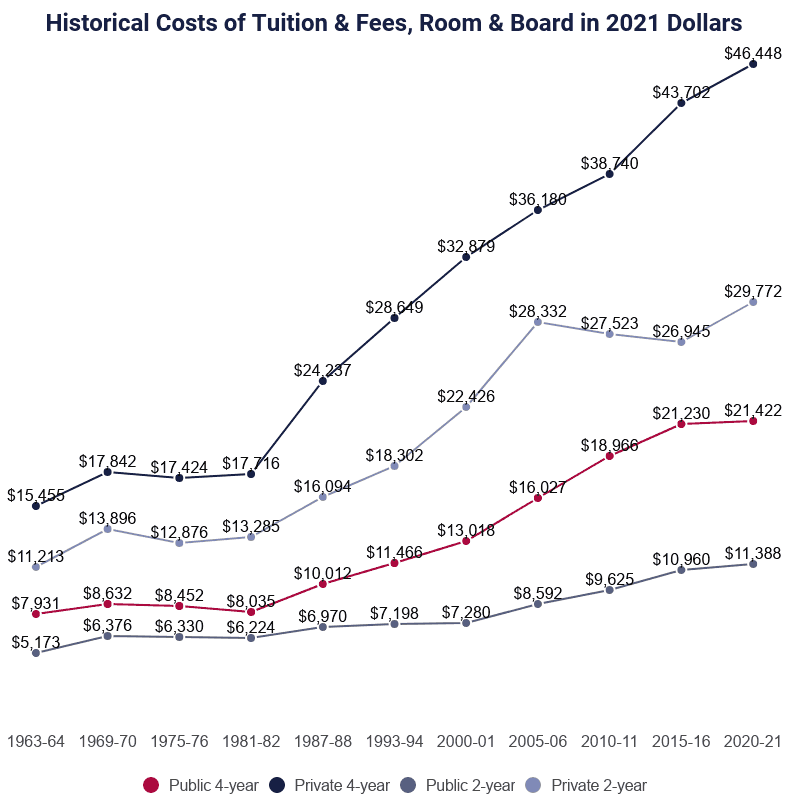
Historical Average Cost of Tuition
The cost of tuition has increased significantly over the last 40 years even after adjusting for inflation.
- In 1963, the annual cost of tuition at a 4-year public college was $243, which is $2,078 when adjusted for inflation.
- Adjusting for inflation, the cost of tuition has increased by $7,502 or 361%.
- Between 2010 and 2020, the average tuition increase at 2-year colleges was $1,005 or 41.2%.
- For 4-year institutions, the average tuition increased 34.3% or by $2,448 at public 4-year institutions and 48.9% or $10,881 at private 4-year institutions.
- From 1989 to 2016, college costs increased almost 8 times faster than wages.
- In 1963, the cost of a 4-year-degree was $42,220 ($5,144 before inflation).
- In 1989, the same degree cost $52,892; by Fall 2020, $101,584 was the price of a bachelor's degree.

Average Cost of Books & Supplies
Some programs require more expensive materials than others, so the cost of books and supplies varies widely.
- At public 4-year institutions, students pay an average of $1,334 annually on books and supplies.
- Books and supplies at private, non-profit institutions average $1,308; at private, for-profit institutions, the average cost is $1,194.
- At public 2-year institutions, students pay an average of $1,585 each year for books and supplies.
- At private, nonprofit institutions, books and supplies average $1,061; at private, for-profit 2-year colleges, the average cost is $1,393.
Average Cost of Room & Board
The determining factor in the cost of room and board is whether the student lives on or off campus.
- At 4-year institutions, the cost of room and board ranges from $10,216 to $11,945.
- At public 4-year institutions, students living on campus pay an average of $11,451 annually for room and board; off-campus boarders pay $10,781.
- At private, nonprofit institutions, on-campus boarders pay an average of $12,682 per academic year; students living off campus pay $9,762.
- At private, for-profit institutions, on-campus room and board averages $10,654; students living off campus pay an average of $8,027.
- There is wider variation in room and board costs at 2-year institutions.
- At public 2-year institutions, students living on campus pay an average of $7,165 for their annual room and board; students living off campus pay $9,316.
- At private, nonprofit 2-year colleges, on-campus boarders pay $11,723 annually; off-campus boarders pay $9,429.
- Private, for-profit institutions charge $10,369 on average for room and board; students living off campus pay $9,222.
Average Additional Expenses
Necessary living expenses, such as transportation, personal care, and entertainment, may be included in the final total cost of college attendance. These expenses vary according to the local economy as well as the student's housing status.
- Additional expenses at 4-year institutions range from $3,201 to $4,471.
- Students living on campus at a public 4-year institution pay an average of $3,493 in additional annual expenses.
- Students who live off campus may expect to pay $4,221 if they do not live with family; for students living with family, additional expenses average $4,253.
- At private, nonprofit 4-year institutions, students living on campus spend an average of $2,758 on additional expenses.
- Students living off campus alone or with nonfamily members spend $5,527 on additional living expenses; those living off campus with family spend $4,236.
- At private, for-profit institutions, additional expenses average $4,748 for students living on campus.
- Students who live off campus spend an average of $4,254; those who live off campus with family spend $4,497.
- At 2-year institutions, additional expenses average between $3,349 and $4,278.
- Students living on campus at a public 2-year institution pay an average of $3,401 in additional annual expenses.
- Students living off campus pay $4,197 in additional expenses; students living off campus with family have an average of $4,271 in annual expenses.
- Students living on campus at 2-year private, nonprofit institutions pay an average of $2,650 in additional annual expenses.
- Students living off campus alone or with nonfamily members spend $4,642, while students living off campus with family members spend $4,726.
- Students at private, for-profit 2-year institutions spend an average of $3,773 on additional expenses if they live on campus.
- Students living off campus spend $5,039 if they do not live with family members; students who live off campus with family spend an average of $4,464.
Average Cost of Lost Income
One of the largest expenses for students enrolled in college may be the loss of potential income in time spent studying instead of working.
- The average weekly income for a high school graduate is $763, or $39,676 per year.
- In four years, the average worker with a high school diploma earns $158,704, or $108,649 after taxes.
- 17% of college students have been homeless within the last 12 months.
- 56% of students experience housing insecurity each year.
- Military veteran students are 61% more likely to experience housing insecurity and 23% more likely to experience homelessness.
- 45% of students experience frequent food insecurity.
- Over 50% of students from 2-year institutions and 44% of 4-year students worry about running out of food.
- Nearly 50% of students can not afford balanced meals.
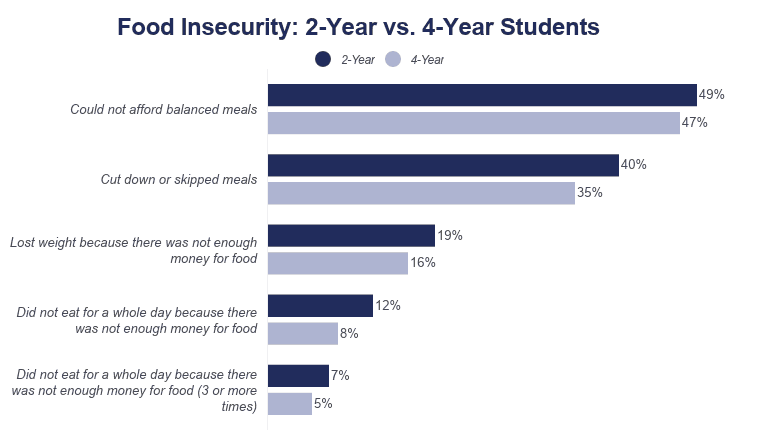
Average Cost of Borrowing for College
Most students borrow money to attend college, later repaying the principal plus interest. All of this compounds the longer the student is in school.
- The average student loan debt is $37,584.
- Each year, 34% of students borrow money to pay for college.
- The average student borrows more than $30,000 to attend school.
See our reports on Student Loan Debt and How to Pay for College to learn more. 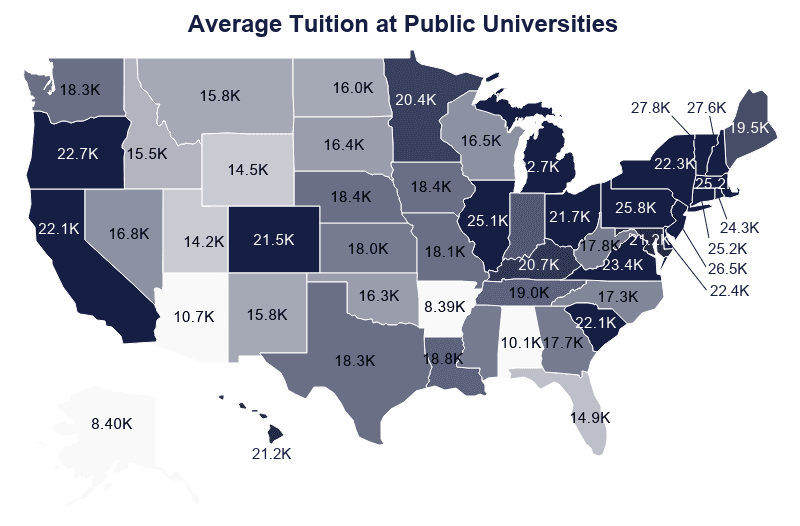
Average College Costs by State
The average cost of in-state tuition and fees varies state-to-state and year-to-year. The range of difference in tuition alone is over $11,000.
- The most expensive public schools are in the Northeast, in and around what is traditionally called New England.
- Many of the most expensive private schools are also in this region.
- The average tuition among the 10 most expensive states for public university is $14,297.
- The least expensive schools are in the South and Plains regions; the least expensive private schools are also predominantly in the South.
- The average tuition among the states with the most reasonably priced public universities is $6,988
For more information, see our report on the Average Cost of College by State.
| State | Tuition & Fees | Total |
|---|---|---|
| Vermont | $17,102 | $29,541 |
| New Hampshire | $16,819 | $28,989 |
| New Jersey | $14,382 | $28,305 |
| Massachusetts | $13,685 | $27,591 |
| Pennsylvania | $15,256 | $27,076 |
| Connecticut | $13,348 | $26,989 |
| Illinois | $14,687 | $26,233 |
| Rhode Island | $12,953 | $25,572 |
| Virginia | $13,815 | $25,227 |
| Delaware | $10,925 | $24,150 |
| Michigan | $13,275 | $24,077 |
| South Carolina | $13,403 | $23,806 |
| Arizona | $10,986 | $23,798 |
| New York | $8,430 | $23,745 |
| California | $8,362 | $23,344 |
| Oregon | $10,595 | $23,263 |
| Ohio | $10,370 | $22,818 |
| Maryland | $9,807 | $22,552 |
| Colorado | $9,676 | $22,523 |
| Hawaii | $10,251 | $22,521 |
| Kentucky | $10,994 | $21,952 |
| Minnesota | $11,722 | $21,486 |
| National Average | $9,488 | $21,216 |
| Maine | $10,228 | $20,801 |
| Iowa | $10,265 | $20,726 |
| Alabama | $10,442 | $20,581 |
| Indiana | $9,502 | $20,348 |
| Tennessee | $10,083 | $20,304 |
| Alaska | $8,648 | $20,150 |
| Nebraska | $8,721 | $20,138 |
| Washington | $7,247 | $19,850 |
| Louisiana | $9,639 | $19,782 |
| Texas | $8,938 | $19,342 |
| Kansas | $9,209 | $19,177 |
| West Virginia | $8,256 | $19,015 |
| Mississippi | $8,590 | $18,943 |
| Missouri | $8,811 | $18,665 |
| Georgia | $7,539 | $18,543 |
| Arkansas | $8,643 | $18,516 |
| Nevada | $6,020 | $18,028 |
| North Carolina | $7,389 | $17,821 |
| Wisconsin | $8,958 | $17,687 |
| South Dakota | $9,035 | $17,352 |
| Oklahoma | $8,102 | $17,234 |
| North Dakota | $8,334 | $17,168 |
| Montana | $7,181 | $17,102 |
| New Mexico | $7,109 | $16,744 |
| Idaho | $7,814 | $16,618 |
| Florida | $4,576 | $15,511 |
| Wyoming | $4,734 | $15,078 |
| Utah | $6,933 | $14,821 |
| District of Columbia | $6,065 | Unavailable |
2019-20 values adjusted for 2021-22 inflation
Most Expensive Private Colleges
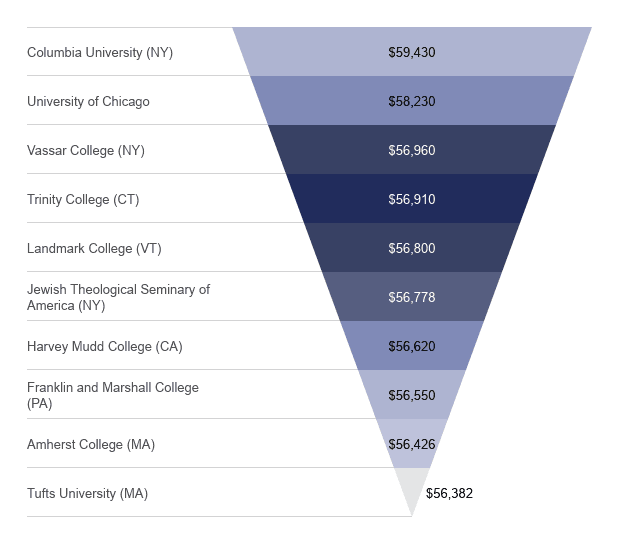
Least Expensive Private Colleges

Analysis: Room and Board On and Off Campus
Living expenses are the second-largest cost of college after tuition and fees. Whether it is less expensive to live on or off campus depends on local rental markets. At Stanford University – located at the center of the San Francisco and San José urban sprawl – students would pay over $24,350 for a shared, off-campus apartment; room and board on campus, however, would cost $19,796 for an academic year. Nearly 60 percent of colleges do not accurately represent off-campus living costs. The University of California-Berkeley estimated a student would pay a median price of $14,360 per academic year (approx. 8 months) to live off-campus. In fact, it would cost a student $15,176 with a roommate in a two-bedroom apartment, adding $816 to their annual budget.
- 87% of students live off-campus.
- Room and board charges have doubled at four-year colleges even after adjusting for inflation.
- In 1980, the average cost of room and board (adjusted for inflation) was $4,800 compared to $9,798 in 2014.
- Between 2003 and 2014, increases for room charges at 4-year colleges outpaced the growth of rent prices.
- In 2003 the average college room charge was 29% under median rent.
- In 2014, the average college room charge was only 7% under median rent.
Cost of College to Taxpayers
Most public institutions receive funding from state and local governments. Colleges also receive federal funding through financial aid to students.
- In 2017, local and state governments spent approximately 10% or $297 billion on higher education compared to 1977, when these expenditures were closer to $105 billion (after adjusting for inflation).
- 98% of state funding for higher education funding and 78% of federal higher education funding went to public institutions.
- For most states, this was the third-largest expenditure, behind elementary/secondary education and public welfare.
- 88% of this spending went towards operational costs, and 12% went towards capital outlays (construction and maintenance).
- In 2017, 85% of higher education spending occurred at the state level.
- The number of FTE (full-time equivalent) students increased by 45% from 2000 to 2012.
- Revenue per FTE student from federal sources increased by 32% compared to a decline in state revenue of 37%.
- Total federal revenue increased from $43 billion to $83 billion (adjusted for inflation).
- Federal loans increased by 375% between 1990 and 2013 compared to 60% enrollment growth.
- As many as 50% of students at 2-year institutions received enough financial aid and grant money to cover tuition and fees.
- Full-time students enrolled at 2-year institutions receive an average of $4,050 in financial aid and grant money.
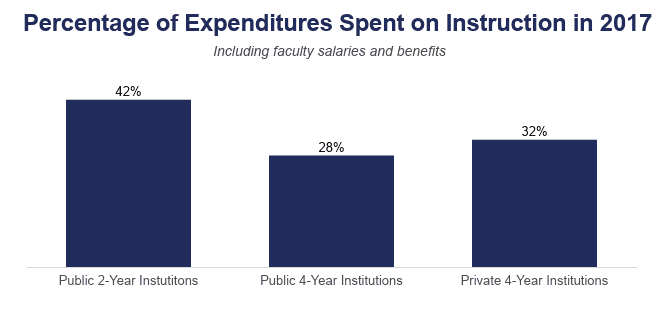
Analysis: College Cost Variations
The significant difference between in-state tuition and out-of-state tuition at a public college or university is due to regional and state reciprocity agreements. These stipulate requirements for discounted or in-state tuition rates within the regions.
- The Southern Regional Education Board's Academic Common Market allows residents of 15 member states in-state tuition at any of the participating colleges in any of the other member states—provided the out-of-state school offers a degree program the student could not get in their home state.
- In New England, the Regional Student Program includes Vermont, Connecticut, Maine, Rhode Island, Massachusetts, and New Hampshire. Like the Academic Common Market, the school must offer a degree program not available in the student's home state.
- Other states offer a reduction of the out-of-state tuition for bordering or regional states, although students are still paying a higher rate than in-state tuition. These include the Midwest Student Exchange Program and the Western Undergraduate Exchange Program . These programs don't typically require students to pursue a degree that's not offered in their home state.
- Active-duty servicemembers and members of their families may qualify to receive in-state tuition, regardless of whether they are permanent residents of the state they are currently stationed in.
- Eighteen states offer in-state tuition for undocumented students, along with other scholarships and financial aid options.
- Three states (Arizona, Georgia, and Indiana) have laws that prohibit colleges in their state from offering in-state tuition to undocumented students.
- Neither Alabama nor Georgia allows undocumented students to enroll in college at all.
Note: North Dakota participates in both the Midwest Student Exchange AND the Western Undergraduate Exchange. 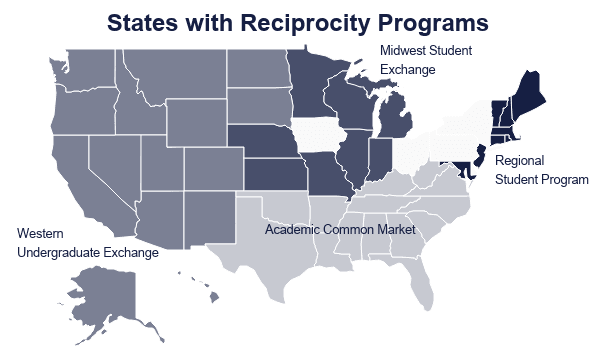
Even with financial aid, 70% of universities are unaffordable for most working-class and middle-class students.
Analysis: Why is College So Expensive?
Some of the biggest contributors to the increasing costs of attending college include increased demand, increased availability of financial aid, and more amenities designed to attract higher-paying students.
- In 2017, there were 5.1 million more students attending college than there were in 2000.
- Increased availability of financial aid for students represents increased funding from federal sources for institutions.
- For-profit schools charge 75% more in tuition when students are eligible for federal loans.
- Students increasingly attend college away from home.
- Increasingly, colleges are spending more on administrative fees.
- Student amenities can account for as much as $3,000 per student per year.
- Between 1975 and 2005, the number of administrators had increased by 85% and administrative staffers by over 240%.
- Between 1993 and 2007, instructional spending per student increased by 39% compared to 61% increase in administrative spending per student.
- Colleges are increasingly hiring adjunct professors (non-tenure track and paid less than full-time professors) to save money.
- Between 2003 and 2013, non-tenure track faculty (adjuncts) had increased from 45% to 62% in 4-year schools.
- In 2018, 73% of all faculty positions were non-tenure track (adjuncts or yearly contracted).
- In 2016, higher-ed institutions hired 21,511 full-time tenure-track faculty compared to 30,865 non-tenure track faculty.
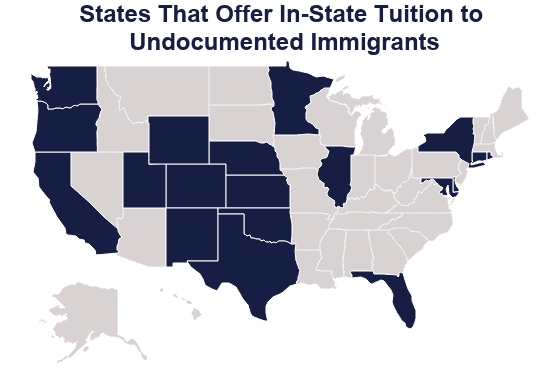
Sources
- SchoolMoney.Org, "College Tuition: Where Does the Money Go?"
- U.S. Department of Education's College Affordability and Transparency Center
- Southern Regional Education Board, "Academic Common Market."
- National Conference of State Legislatures, "Undocumented Student Tuition: Overview."
- Parent Toolkit, "Public vs. Private Colleges."
- Federal Student Aid, "Federal Pell Grants."
- National Center for Education Statistics (NCES), Digest of Education Statistics.
- NCES, Integrated Postsecondary Education Data System
- The Future of Statewide College Promise Programs
- Tuition and State Appropriations
- Federal and State Funding of Higher Education
- Many Colleges Miscalculate Off-Campus Housing Costs
- Does Federal Student Aid Raise Tuition? New Evidence on For-Profit Colleges
- Education at a Glance 2018: OECD Indicators
- Federal Student Aid, "FSEOG Grant."
- The Hechinger Report, "Are Too Few College Students Asking for Federal Aid?"
- Bureau of Labor Statistics, Measuring the Value of Education
- Federal Paycheck Calculator
- University of California – Berkeley, Student Budgets (Cost of Attendance)
- Stanford University, Community Housing: Housing Types and Costs
Make 50000.00 a Year With 6 Months of Schooling
Source: https://educationdata.org/average-cost-of-college
0 Response to "Make 50000.00 a Year With 6 Months of Schooling"
Post a Comment